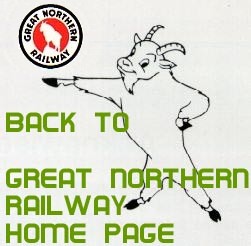|


| |

Great Northern Railway Company
Cascade Mountain Electrification Cascade Division
Instructions for the Operation and Maintenance of Electric Motive Power.
July 1, 1947
(Cover of booklet is dated November 1947)
Page 1
TABLE OF CONTENTS
Qualifying for electric service................................Page 4
Electric locomotive KWH meter charts.....................Page 5
General Information ...........................................Page 6
Chapter I. Preparing Electric Locomotives for Service:
Connecting up air hose between cabs......................Page 8
Lining up air brake details in cabs, electric
engines towed dead in a train................................Page 9
Operation of pantographs and ground switches..........Page 11
Safety precautions, damaged pantographs, ordering
trolley power turned off.......................................Page 12
Special safety precautions. General Electric automatic
high tension bus connectors..................................Page 13
General Electric and Westinghouse high tension
bus line on locomotive roof..................................Page 14
Starting up dead General Electric motor generator
set.................................................................Page 15
Shutting down General Electric locomotive, special
note to all locomotive crews about road
shut downs, General Electric compressor fuses
location...........................................................Page 16
General Electric compressors normal operation,
compressor selector switches and emergency
power for pumps when coming down hill with
dead trolley line................................................Page 17
General Electric locomotive compressor troubles......Page 18
Pumps fail to stop..............................................Page 19
Electric locomotive blowers or cooling fans, General
Electric transformer blowers, traction
motor blowers..................................................Page 20
Starting up dead Westinghouse locomotive.............Page 21
Testing Westinghouse locomotives before leaving
shop or terminal...............................................Page 22
Shutting down Westinghouse locomotive................Page 23
Special precautions when restarting Westinghouse
Motor Generator sets, Westinghouse
locomotive compressor operation.........................Page 24
Page 2
Westinghouse blowers or cooling fans...................Page 25
Safety precautions...........................................Page 26
General Electric and Westinghouse locomotives,
winter ventilation............................................Page 27
Chapter II. Electric Locomotive Operation:
Westinghouse units.........................................Page 29
Special data on reversing Westinghouse units........Page 33
General Electric units.......................................Page 34
Local classification of General Electric cabs...........Page 35
Differences in control of General Electric cabs........Page 36
General Electric units --
Putting into regeneration from running................Page 37
Train operation in electrified territory.................Page 38
Safety precautions.........................................Page 39
Operating tonnage freights, head end and helper
service, motoring and regeneration...................Pages 40
to 46
Chapter III. Electric Locomotive Troubles:
General Electric dead cab motor generator set
sequence.....................................................Page 47
General Electric. Explanation of events during
sequence tests for motor generator starting,
straight motoring, field shunting and
regeneration................................................Page 50
General Electric. Power sequence, synchronizing
trouble, motoring, and regeneration switch
sequence....................................................Page 51
Westinghouse dead cab motor generator set
sequence....................................................Page 52
Westinghouse sequence of motoring, high speed
motoring, regeneration, blower, and motor
generator set switches...................................Page 53
General data on trouble shooting......................Page 54
General Electric trouble shooting, pantograph
raising trouble..............................................Pages 55 and
57
Page 2a
General Electric motor generator troubles, starting
and synchronizing.........................................Pages 56-57
General Electric engine fails to move.................Page 58
General Electric engine fails to regenerate,
JR circuit breakers.........................................Pages 59-60
General Electric ground relay...........................Page 60
General Electric trolley relay, M-G overspeed,
PR3, OLR4 relays, Pantograph relay..................Pages 61-62
General Electric SR relay and TDR1...................Pages 62-63
General Electric TDR2, temperature relay, traction
overloads, and BR relay.................................Page 63
General Electric voltage regulator, and X1, X2
relays........................................................Pages
64-65-66
Westinghouse Trouble Shooting:
Motor generator set fails to start......................Page 66
Motor generator set synchronizing trouble..........Page 67
Engine fails to move in straight motoring...........Page 68
Engine fails to operate in separate motoring,
or regeneration...........................................Pages 69-70
Trouble Shooting General Electric and Westinghouse:
Control jumpers..........................................Page 71
Westinghouse Relays...................................Page 71
Oil circuit, breaker trip, synchronous motor overload
trip, exciter overload, transition relay,
blower relay..............................................Pages
72 and
73
Limit relay, M-G overspeed, line relay.............Page 73
Traction overloads, AR time delay relay, and
the method of determining which relay is causing
trouble.....................................................Page 74
Ventilation relay protecting transformer,
synchronizing relays SR1, and SR2.................Pages 75-76
Page 2b
General Notice
Every employee whose duties are in any way connected
with the operation and maintenance of the electric
locomotives, is required to be familiar with the apparatus he
is called upon to operate and repair in the performance of
his duties and will be examined from time to time as to his
qualifications for such duties by such persons as are
appointed by proper authority. Engineers and firemen are
required to familiarize themselves with the name and
location of all apparatus. Engineers, in addition to above,
are required to know the principle of operation of the
various pieces of apparatus, the manner in which they should
be operated, and the method of procedure in case of failure.
Inspectors and electricians, in addition to the above, are
required to be familiar with the construction and details of
the apparatus and methods of making repairs.
Page 3
Qualifying For Electric Service
(a) Engine crews qualifying for electric service, should
primarily be men who are already qualified to railroad in
mountain territory, regardless of what kind of power is
used.
This is merely a safety precaution, as a loss of trolley
power on electrics may mean handling trains on grade
with air brakes.
(b) Engineers and firemen qualifying on electric locomotives
will report to Foreman at Appleyard Electric Shop
for preliminary instructions, which consist of learning the
SAFE methods of starting and shutting down General
Electric and Westinghouse motor generator sets on locomotives,
the locations, positions and functions of relays,
switches and fuses, as well as the proper way to change
out blown fuses, reset tripped relays and to tell by
inspection when a switch or relay is energized and operating
properly.
The location of bearings on motor generator sets,
traction motors, blower motors, compressors, motor
suspension bearings, truck and driver boxes, how to temporarily
fix up bad order ones to get over road, and mainly how to
report properly the location of detective apparatus regardless
of which end you happen to be operating from; the
locations must all be in respect to "F" end as covered in
another part of these instructions.
Both engineers and firemen get the same preliminary
instructions to familiarize them with locomotives. They
will then be instructed in the proper method of lining up
the three way cut out cocks and air brake apparatus on
electrics, which differ somewhat in details from the steam
power on account of double end controls on electrics.
This also will include method of coupling up controls,
air and electric, for multiple unit operation.
Methods of operating the electric cabs in motoring and
regeneration will be taught. Remembering that there are
two different designs of the same type of motor generator
locomotive in service, Westinghouse and General Electric,
and both are alike except for details, men must be familiar
with both locomotives.
(c) Student trips on road with regular crews will follow
the preliminary instructions at shop. Engineers will make
trips on freight, head end and helper, observing how
regular men handle the job; also on through and local
Page 4

 
|